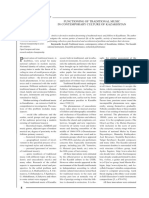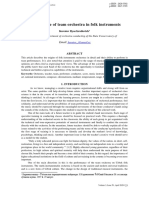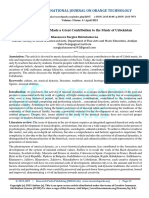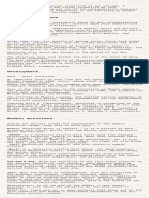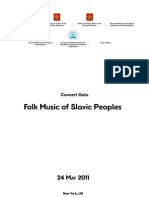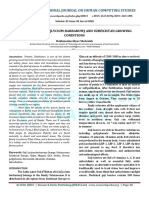About Makom Melodies Adapted For Orchestra of Uzbek Folk Instruments
About Makom Melodies Adapted For Orchestra of Uzbek Folk Instruments
Uploaded by
researchparksCopyright:
Available Formats
About Makom Melodies Adapted For Orchestra of Uzbek Folk Instruments
About Makom Melodies Adapted For Orchestra of Uzbek Folk Instruments
Uploaded by
researchparksOriginal Title
Copyright
Available Formats
Share this document
Did you find this document useful?
Is this content inappropriate?
Copyright:
Available Formats
About Makom Melodies Adapted For Orchestra of Uzbek Folk Instruments
About Makom Melodies Adapted For Orchestra of Uzbek Folk Instruments
Uploaded by
researchparksCopyright:
Available Formats
INTERNATIONAL JOURNAL ON ECONOMICS, FINANCE AND
SUSTAINABLE DEVELOPMENT
Available online at www.researchparks.org
IJEFSD
RESEARCH PARK
Journal homepage: www.researchparks.org/
ABOUT MAKOM MELODIES ADAPTED FOR ORCHESTRA OF
UZBEK FOLK INSTRUMENTS
* Abdujalil Abdusattorov
*Fergana State University Teacher of the department “Music Education”
E-mail: abdujalil091992@gmail.com
ABSTRACT ARTICLE INFO
In this article, given the information about the Article history:
Received 07 Oct 2020
classification of musical works created in the style of makom by Received in revised form 10 Nov 2020
famous composers of Uzbekistan for orchestra of folk Accepted 15 Nov 2020
instruments. There will also be given a brief commentary on
musical works created in the tradition of makom. Keywords:
Click here and insert your abstract text. maqom tradition, musical treasure,
© 2020 Hosting by Research Parks. All rights reserved. orchestra, symphony orchestra,
oratorio, musical folklore,
compositional creativity.
1. Introduction
We all know that by the twentieth century, a number of radical changes and musical reforms have taken place in
the Uzbek musical culture. In particular, the emergence of the early genres of musical drama and comedy, as well as the
invitation of Russian composers and musicologists to Tashkent, led to significant changes in the scientific and creative sphere.
1
2. Main part
The field of composition, which was established in the twenties of the last century, introduced its first varieties
into practice.
First of all, the makom samples, which are the heritage of our national music art, were collected, recorded and
sealed for eternity in the form of a book. At the same time, folk songs, samples of musical folklore, musical instruments,
epics were recorded by famous folklorists with the help of phonograph.
Second, compositional creativity, a young field of music art, presented its first creative results to music enthusiasts.
If the first creative exercises were written with quotes from folk melodies, maqom samples, the creative experience of local
artists and the works of famous composers especially Mukhtor Ashrafi, Tolibjon Sodiqov, Mutal (Mutavakkil) Burhanov,
Manas Leviev, Sulaymon Yudakov, Sayfi Jalil should be especially noted.
The next period is the late 30s to the early 40s. During this period, an orchestra of folk instruments was formed
and fruitful work was done on its creative program. Makom traditions, using the ways of singing as a quote, enriched with
E-mail address: info@researchparks.org
Peer review under responsibility of Emil Kaburuan.
ISSN (electronic): 2620-6269/ ISSN (printed): 2615-4021 . Hosting by Research Parks All rights reserved.
INTERNATIONAL JOURNAL ON ECONOMICS, FINANCE AND SUSTAINABLE DEVELOPMENT ISSN (electronic): 2620-6269/ ISSN (printed): 2615-4021 29
national musical thinking, polyphonic elements, artistically and aesthetically perfect musical works were created from each
other.
In the composition of the Uzbek composers, the processing of makom melodies with the help of a jeweler's
approach to the performance of symphonic and folk orchestras was carried out at a rapid pace. In this regard, the creative
works of such composers as Mutal Burhanov, Felix Yanov-Yanovsky, Mirsodik Tadjiev, Sayfi Jalil, Mirkhalil Makhmudov,
Mustafo Bafoev, Habibulla Rakhimov was clearly visible. 2
Uzbek composers have effectively used a variety of methods and techniques for processing makoms. First of all, the
maqom tracks were taken in their original form without any change in their fret, melody-rhythmic bases. This is the case in
“Soqiynomai Mog’ulchai Segoh” better known as “Nasri Segoh”, “Qashqarchai Rok” and its Ufor and we can observe in the
revised versions of several maqom roads that are popular in Fergana and in Tashkent.
We can see the first attempts in this direction in the works of famous composers Felix Yanov-Yanovsky and
Mirsodiq Tadjiev. For example, in the 1st part of M.Tojiev’s 9th symphony “Mog’ulchai Dugoh” is thematically, in the 2nd
part the method of sokiynoma is preserved, in the 3rd part Ufor, in the 4th part “Mogulchai Dugoh” is accompanied with the
melody “Sarahbor”. It is obvious that Shashmaqom, our golden heritage, has attracted composers like a valuable magnet.
After the transition of our national instruments to the tempered system, the orchestra of folk instruments appeared
in our country and developed and improved. Gradually, composers Fahridin Sodiqov, Saidjon Kalonov, Muhammadjon
Mirzaev, Tuhtasin Jalilov and other well-known composers created musical works for the orchestra of folk instruments. Later,
such works began to appear in the composition works. Composer Sabir Boboev’s “Holiday Overture” for the instrument
named “chang” and orchestra “Concertino” is a professional work written for orchestra of folk instruments. 3
One of the masterpieces of Uzbek symphony, Mirsodiq Tadjiev, in his work, along with symphonic music, we can
see many works written for orchestra of folk instruments.
1. Oratorio “Shodiyona”. Poem by Maruf Qoriev. For choir soloists and orchestra. Dedicated to the 50th anniversary of
the Uzbek SSR. 1973 y.
2. “Concert” overture. 1977 y.
3. "Concertino" for piano and orchestra in 1977, "Melody" in 1978, Ophelia Yusupova (on piano).
4. Overture "Youth". For orchestra of folk instruments. 1978 y.
5. “Sarafruz”. For orchestra of folk instruments. 1978 y.
6. Overture “Tantana”. For orchestra of folk instruments. 1979y
7. “Overture”. For orchestra of folk instruments. 1980y.
8. Concert for neighbors and orchestra. For orchestra of folk instruments. 1991y.
9. Concert. For drums and orchestras of folk instruments. 1991 y.
10. “Concert-sarafruz” for folk orchestra. 1992y.
11. Concert. For the orchestra of Uzbek folk instruments 1992.
Later, in the 50s of the XX century, radical changes took place in the performance of the orchestra of folk
instruments. The famous artist Boris Gienko, who made a great contribution to the development of the Uzbek school of
composition, enriched our art by writing musical works in various genres as a versatile and talented composer. He also wrote
masterpieces for the orchestra of folk instruments. In his work for orchestra of flute and folk instruments, he used samples of
maqom as a quote from “Wild Chorgoh”.
Today, the talented composer Mustafo Bafoev, who has been writing works in all musical genres, has written many
works for the orchestra of folk instruments. His works are written with deep thought in all respects. We can list M. Bafoev's
E-mail address: info@researchparks.org
Peer review under responsibility of Emil Kaburuan.
ISSN (electronic): 2620-6269/ ISSN (printed): 2615-4021 . Hosting by Research Parks All rights reserved.
INTERNATIONAL JOURNAL ON ECONOMICS, FINANCE AND SUSTAINABLE DEVELOPMENT ISSN (electronic): 2620-6269/ ISSN (printed): 2615-4021 30
“Sugdcha”, “Bukhara concert”, “Concerto” for orchestra of folk and folk instruments, “Concerto” for tanbur and orchestra
of folk instruments and many others. In the work of Mustafa Bafoev, he skillfully used our status, which is our national
music. For the orchestra of tanbur and folk instruments, he used the melody “Savti Munojot” at the “Concert” and sang it
with great taste. The musical work is professionally written in all respects and embodies national traditions and styles.
If we look at the musical analysis of the work “Concerto” for the orchestra of tanbur and folk instruments, the
musical work is in the tone of a-moll, 3/4 size, written in Allegro moderato. The input part consists of 8 clock cycles. The
main theme of the work, in the national tone, is not quoted from the ways of status. The metro-rhythm of the melody, the
tendency of its development, shows that in the tanbur saz it uses its own possibilities of performance, in particular, melismas
and the orchestra mainly performs the role of accompaniment. Starting with number 2 (zero), the connecting part is in D-dur
tone, in a variant very similar to the main theme. Once a theme is complete, the transitions to other tonalities similar to that
theme remind us of the songs and melodies in the Prose and Difficulty section of our maqoms. The numbers 3,4,5 are in the
same square and consist of a cycle of 8 bars.
Numbers 6-12 are on a 5/8 scale, which is a development of Part 1, and the topics in each number (zero) consist of
an extended period. Changes in tones, alterations and the occurrence of chromatic sounds are evidence of development. The
rhythm is preserved in this part as well. Number 13 comes with a lyrical theme and section specific to the makom tracks in
Andante speed, A-dur tonality, 7/8 scale. Continues to number 17. Number 18 begins with Cadence, in which the status of
“Savti Navo” is used in full. A certain part of the cadence, that is, the absence of bars, can be felt in the modern “Avangard”
style. Reprinting through the changes in Figure 19 leads to the main part. Then its tonality ends at a-moll.
Composer Habibulla Rakhimov is also effective in this field and has written many musical works. There are many
works for solo instruments and orchestral works by the artist. In the annual “Festival” in our country, ie in the competitions
for folk instruments, the works of the artist are performed as a mandatory work. The composer wrote "Oratorio" for solo,
sukhandon, choir and orchestra of folk instruments. In this play, the status of “Segoh” is quoted in the party of the protagonist
Bahauddin Naqshbandi, and the status of “Chorgoh” is also used effectively.
3. Conclusion
It should be noted that the musical works created by Uzbek composers have received great acclaim on the world
stage. Effective work is being done in this direction these days, and new musical works are being created by young composers.
Among the musical works of recent years, especially in the works written for the orchestra of folk instruments, we can observe
examples of creative experience typical of the Fergana-Tashkent maqom. After all, maqoms are a musical treasure of the
Uzbek people and will undoubtedly serve as the main source of creativity for many centuries.
REFERENCES
Modern technologies in the works of Uzbek composers: problems and solutions. Proceedings of the student
scientific-theoretical conference. Toshkent., 2019.
Jabborov "Composers and musicologists of Uzbekistan" - T., 2004
R. Abdullaev “Uzbek classical music” - T., 2008.
R. Yunusov “Mirsodiq Tojiev” (Monograph) - T., 2018.
E-mail address: info@researchparks.org
Peer review under responsibility of Emil Kaburuan.
ISSN (electronic): 2620-6269/ ISSN (printed): 2615-4021 . Hosting by Research Parks All rights reserved.
You might also like
- Ockeghem - Missa Prolationum (Analysis)Document4 pagesOckeghem - Missa Prolationum (Analysis)Matt CramerNo ratings yet
- The Library of Classical Guitar ClassicsDocument257 pagesThe Library of Classical Guitar ClassicsPatryk Szafron100% (11)
- Siampani Wisc 0262B 17728Document263 pagesSiampani Wisc 0262B 17728Sasha PozelliNo ratings yet
- Toru TakemitsuDocument33 pagesToru TakemitsuDamian Guardia Salazar100% (2)
- Components of OperaDocument4 pagesComponents of OperaElycris Bravo100% (1)
- F. Weingartner - On ConductingDocument64 pagesF. Weingartner - On ConductingCsibi Dávid67% (3)
- 189241-Article Text-556020-1-10-20190515Document17 pages189241-Article Text-556020-1-10-20190515LuisCarrillo100% (1)
- 007 Notation of Complex Examples of UzbekDocument7 pages007 Notation of Complex Examples of Uzbekmarufjonashurov51No ratings yet
- About The First Performances of Works by Uzbek Composers For PianoDocument4 pagesAbout The First Performances of Works by Uzbek Composers For PianoResearch ParkNo ratings yet
- On The Issue of The Role of The Piano Ensemble in The Work of A. Latif-ZadeDocument3 pagesOn The Issue of The Role of The Piano Ensemble in The Work of A. Latif-ZadeCentral Asian StudiesNo ratings yet
- The Process of Changing Modern Traditions in The Uzbek Opera TheaterDocument4 pagesThe Process of Changing Modern Traditions in The Uzbek Opera TheaterResearch ParkNo ratings yet
- An Analytical Look at The History of The Art of Uzbek Folk InstrumentsDocument4 pagesAn Analytical Look at The History of The Art of Uzbek Folk InstrumentsResearch ParkNo ratings yet
- The Role and Significance of Chorus in National OperaDocument4 pagesThe Role and Significance of Chorus in National OperaResearch ParkNo ratings yet
- 015 To Teach Students of Higher Education MusicDocument5 pages015 To Teach Students of Higher Education Musicmarufjonashurov51No ratings yet
- To Promote The Importance of Developing Folk and Traditional Performing Arts in UzbekistanDocument5 pagesTo Promote The Importance of Developing Folk and Traditional Performing Arts in UzbekistanResearch ParkNo ratings yet
- 005 Teaching The Song of SingingDocument9 pages005 Teaching The Song of Singingmarufjonashurov51No ratings yet
- Characteristics of Choir Recording, in The Creation of Composer Mustafo BafoyevDocument4 pagesCharacteristics of Choir Recording, in The Creation of Composer Mustafo BafoyevResearch ParkNo ratings yet
- A Look at The History of The Musical Heritage of Uzbek PeopleDocument4 pagesA Look at The History of The Musical Heritage of Uzbek PeopleAcademic JournalNo ratings yet
- Ancestors' Heritage in The Uzbek Musical ArtDocument4 pagesAncestors' Heritage in The Uzbek Musical ArtresearchparksNo ratings yet
- 016 To Teach Higher Education Music StudentsDocument4 pages016 To Teach Higher Education Music Studentsmarufjonashurov51No ratings yet
- Folk Festivities During Kokand KhanateDocument4 pagesFolk Festivities During Kokand KhanateresearchparksNo ratings yet
- From The History of Music Education in UzbekistanDocument7 pagesFrom The History of Music Education in UzbekistanresearchparksNo ratings yet
- Conditions Created For The Upbringing of A Harmoniously Developed GenerationDocument5 pagesConditions Created For The Upbringing of A Harmoniously Developed GenerationAcademic JournalNo ratings yet
- 99-103 Conditions Created For The Upbringing of A Harmoniously Developed GenerationDocument5 pages99-103 Conditions Created For The Upbringing of A Harmoniously Developed GenerationAcademic JournalNo ratings yet
- 012 Exploring The Work of George Bizet in Music EducationDocument7 pages012 Exploring The Work of George Bizet in Music Educationmarufjonashurov51No ratings yet
- Functioning of Traditional Music in Contemporary Culture of KazakhstanDocument3 pagesFunctioning of Traditional Music in Contemporary Culture of KazakhstanwulpanazharNo ratings yet
- Performance of Team Orchestra in Folk InstrumentsDocument5 pagesPerformance of Team Orchestra in Folk InstrumentsresearchparksNo ratings yet
- Dynastic Artists Who Made A Great Contribution To The Music of UzbekistanDocument4 pagesDynastic Artists Who Made A Great Contribution To The Music of UzbekistanResearch ParkNo ratings yet
- Activity Sheets in Music: Quarter 1Document16 pagesActivity Sheets in Music: Quarter 1Sharlyn BalgoaNo ratings yet
- Андре́й Ви́кторович Ано́хинDocument4 pagesАндре́й Ви́кторович Ано́хинЖанна УхановаNo ratings yet
- EN Kecimol Music As Cultural IdentificationDocument5 pagesEN Kecimol Music As Cultural IdentificationHye RaNo ratings yet
- ijsrmjournalGirmawAshebirresearch (1) 232Document7 pagesijsrmjournalGirmawAshebirresearch (1) 232Heonk YishakNo ratings yet
- Babadjanian SonataDocument16 pagesBabadjanian SonataDina BikzhanovaNo ratings yet
- The Study of The Life and Creativity of Yunus Rajabi and The Rich Heritage He Left To The Uzbek NationDocument4 pagesThe Study of The Life and Creativity of Yunus Rajabi and The Rich Heritage He Left To The Uzbek NationresearchparksNo ratings yet
- Cultivating Students' Aesthetic Taste While Looking at The Works of World Composers in Music LessonsDocument3 pagesCultivating Students' Aesthetic Taste While Looking at The Works of World Composers in Music LessonsResearch ParkNo ratings yet
- Historical Roots of Note WritingDocument6 pagesHistorical Roots of Note WritingAcademic JournalNo ratings yet
- Folks SongsDocument11 pagesFolks SongsJoon Hwang WongNo ratings yet
- Aesthetics in The Traditional Music of Japan - TambaDocument9 pagesAesthetics in The Traditional Music of Japan - TambahelenamxNo ratings yet
- Stage Interpretation of A Historical Work in Musical Theater (On The Example of The Activity of The Karakalpak State Musical Theater)Document5 pagesStage Interpretation of A Historical Work in Musical Theater (On The Example of The Activity of The Karakalpak State Musical Theater)Academic JournalNo ratings yet
- 2489-Article Text-8541-1-10-20211215Document6 pages2489-Article Text-8541-1-10-20211215Jhonnel L. AbadesaNo ratings yet
- Modern Ukrainian MusicDocument1 pageModern Ukrainian Musicgentlemen.official.xxxNo ratings yet
- 020 Composer Mutal BurhanovDocument4 pages020 Composer Mutal Burhanovmarufjonashurov51No ratings yet
- FolkMusicSlavic Brochure2011Document20 pagesFolkMusicSlavic Brochure2011Bulat AndreNo ratings yet
- Uzbek Epic ArtDocument3 pagesUzbek Epic ArtAcademic JournalNo ratings yet
- Stage Interpretations of The Performing ArtsDocument4 pagesStage Interpretations of The Performing ArtsCentral Asian StudiesNo ratings yet
- History of Maqom Art and Its Place TodayDocument3 pagesHistory of Maqom Art and Its Place TodayAcademic JournalNo ratings yet
- Drawings For The Work of The First Changist Fazilat ShukurovaDocument4 pagesDrawings For The Work of The First Changist Fazilat ShukurovaAcademic JournalNo ratings yet
- 01musicologist 10 33906 773604-1215283Document31 pages01musicologist 10 33906 773604-1215283s9ng9t6kdmNo ratings yet
- Theoretical Principles of Aesthetic Education of Students Based On The Music of Makom InstrumentsDocument4 pagesTheoretical Principles of Aesthetic Education of Students Based On The Music of Makom InstrumentsAcademic JournalNo ratings yet
- Lomax Folk PDFDocument29 pagesLomax Folk PDFRıdvan AydınlıNo ratings yet
- Preparation of Future Music Teachers For Their Professional Activities Througii Uzbek Classical MusicDocument6 pagesPreparation of Future Music Teachers For Their Professional Activities Througii Uzbek Classical MusicAcademic JournalNo ratings yet
- Karakalpak Baxshi and The Art of MusicDocument4 pagesKarakalpak Baxshi and The Art of MusicCentral Asian StudiesNo ratings yet
- The Influence of Music On The Elizabethan EraDocument8 pagesThe Influence of Music On The Elizabethan Erakingkola36No ratings yet
- History of Collection and Recording of Samples of Uzbek Music FolkloreDocument4 pagesHistory of Collection and Recording of Samples of Uzbek Music FolkloreEditor IJTSRDNo ratings yet
- Y Kyrylenko N Grebenuk O Batovska T Tesler R Hasanov SUBBM LXVIDocument23 pagesY Kyrylenko N Grebenuk O Batovska T Tesler R Hasanov SUBBM LXVIВарс ВарсNo ratings yet
- Ways of Development of Performing Art in The Master-Apprentice TraditionDocument4 pagesWays of Development of Performing Art in The Master-Apprentice TraditionresearchparksNo ratings yet
- Research ProposalDocument2 pagesResearch ProposalChristopher Matthew RíosNo ratings yet
- БрусиловскийDocument9 pagesБрусиловскийagibayevaNo ratings yet
- Ali Jabiyev. Emin SabitoghluDocument4 pagesAli Jabiyev. Emin SabitoghluSema IsazadehNo ratings yet
- Project of English. Ivan KarabytsDocument4 pagesProject of English. Ivan KarabytsЯна РоманчукNo ratings yet
- Edu Sci - IJESR - Dyusenbek Nakipov - ShankibayevaDocument2 pagesEdu Sci - IJESR - Dyusenbek Nakipov - ShankibayevaTJPRC PublicationsNo ratings yet
- Microteaching Draft - Electronic and Chance MusicDocument8 pagesMicroteaching Draft - Electronic and Chance MusicRHEGINE VALCONCHANo ratings yet
- Bulgarian MusicDocument7 pagesBulgarian MusicStanciu Marius-IonutNo ratings yet
- Samuel Akpabot: The Odyssey of a Nigerian Composer-EthnomusicologistFrom EverandSamuel Akpabot: The Odyssey of a Nigerian Composer-EthnomusicologistRating: 5 out of 5 stars5/5 (1)
- Indicator of Dyscirculatory Encephalopathy in HypothyroidismDocument4 pagesIndicator of Dyscirculatory Encephalopathy in HypothyroidismresearchparksNo ratings yet
- The Conceptosphere of Divine Language in English LinguacultureDocument3 pagesThe Conceptosphere of Divine Language in English LinguacultureresearchparksNo ratings yet
- Structural Causes and Prevalence of Neurosensoral Hearing Loss in Children in Samarkand RegionDocument3 pagesStructural Causes and Prevalence of Neurosensoral Hearing Loss in Children in Samarkand RegionresearchparksNo ratings yet
- Induction of Goji (Lycium Barbarum) and Uzbekistan Growing ConditionsDocument3 pagesInduction of Goji (Lycium Barbarum) and Uzbekistan Growing Conditionsresearchparks100% (1)
- Body Language and Teachers' Attitude in Teaching ProcessDocument3 pagesBody Language and Teachers' Attitude in Teaching ProcessresearchparksNo ratings yet
- Comparison of Strength Between Normal Concrete & Admixture ConcreteDocument8 pagesComparison of Strength Between Normal Concrete & Admixture ConcreteresearchparksNo ratings yet
- Application of IOT Technology in Providing Population Health During The Sars-Cov-2 PandemicDocument4 pagesApplication of IOT Technology in Providing Population Health During The Sars-Cov-2 Pandemicresearchparks100% (1)
- Metal Heating DeviceDocument3 pagesMetal Heating DeviceresearchparksNo ratings yet
- Analysis of The Type of Approximation of The Magnetization Curve For Electromagnetic Converters of High CurrentsDocument3 pagesAnalysis of The Type of Approximation of The Magnetization Curve For Electromagnetic Converters of High CurrentsresearchparksNo ratings yet
- The Importance of Intelligent Control SystemsDocument3 pagesThe Importance of Intelligent Control Systemsresearchparks100% (1)
- Colors in Descriptive ArtDocument3 pagesColors in Descriptive ArtresearchparksNo ratings yet
- The Perspectives of The Digital MarketingDocument5 pagesThe Perspectives of The Digital MarketingresearchparksNo ratings yet
- Feasibility Study of Bongo Village, Gorontalo District As A Religious Tourism DestinationDocument7 pagesFeasibility Study of Bongo Village, Gorontalo District As A Religious Tourism DestinationresearchparksNo ratings yet
- Changes in Preschool Education System in UzbekistanDocument3 pagesChanges in Preschool Education System in UzbekistanresearchparksNo ratings yet
- Methodical Interpretations On The Organization of Independent Educational Classes in The Subject of PaintingDocument4 pagesMethodical Interpretations On The Organization of Independent Educational Classes in The Subject of PaintingresearchparksNo ratings yet
- Voltage Balancing in The System of Power Supply of High-Speed Rail TransportDocument4 pagesVoltage Balancing in The System of Power Supply of High-Speed Rail TransportresearchparksNo ratings yet
- I Wonder Lyrics and ChordsDocument1 pageI Wonder Lyrics and Chordsnayrkrik100% (1)
- Grade 5 Week1 and 2Document6 pagesGrade 5 Week1 and 2Jake MaltoNo ratings yet
- Tongue Blocking Study 2 - Exercises 0Document2 pagesTongue Blocking Study 2 - Exercises 0Özgür ZurnacıNo ratings yet
- Once Upon A Time-ViolaDocument1 pageOnce Upon A Time-ViolaRoberto FioreNo ratings yet
- Serenade: F. SchubertDocument6 pagesSerenade: F. SchubertMirella Loredana CozziNo ratings yet
- Bmu101107 PDFDocument76 pagesBmu101107 PDFVicthoria PerezNo ratings yet
- O's ChordDocument74 pagesO's ChordLeonel HittersNo ratings yet
- He That Shall Endure To The EndDocument2 pagesHe That Shall Endure To The EndShaun MesimelaNo ratings yet
- Schumann's Novellette, Op. 21, No. 1: From The HeartDocument11 pagesSchumann's Novellette, Op. 21, No. 1: From The HeartDavid ZaragozaNo ratings yet
- Lesson Plan Format Launguage Arts and Music IntegrationDocument11 pagesLesson Plan Format Launguage Arts and Music IntegrationMartha Andrea PatcoNo ratings yet
- Glenn Miller Medley BassDocument4 pagesGlenn Miller Medley BassMaestroNo ratings yet
- 8 Quando Sento Che Mi AmiDocument22 pages8 Quando Sento Che Mi AmiGiuseppe BonaccoltaNo ratings yet
- Forever (G)Document1 pageForever (G)ebolutionateNo ratings yet
- LRSM Programme Notes FINAL PDFDocument7 pagesLRSM Programme Notes FINAL PDFNeiphreno Puro TetseoNo ratings yet
- MARIANO MELGAR Trombón 1Document2 pagesMARIANO MELGAR Trombón 1Fharyd AriasNo ratings yet
- Zitti e Buoni-Rhythm - GuitarDocument6 pagesZitti e Buoni-Rhythm - GuitarCristina Serra De TorresNo ratings yet
- How Bout A Dance?: RubatoDocument4 pagesHow Bout A Dance?: RubatokatieNo ratings yet
- Oboe and PianoDocument6 pagesOboe and PianoLuca NewmanNo ratings yet
- Christmas Sanctus (SAB) - NOTATIONDocument3 pagesChristmas Sanctus (SAB) - NOTATIONmorisonksi.elearningNo ratings yet
- Free Fee Zell Theory Book Vol 1Document46 pagesFree Fee Zell Theory Book Vol 1yhannaNo ratings yet
- 4 Romantic Waltzes by Edmar Fenicio PDFDocument9 pages4 Romantic Waltzes by Edmar Fenicio PDFClaudio RaiolaNo ratings yet
- Eluveitie - ThousandfoldDocument3 pagesEluveitie - ThousandfoldMystingNo ratings yet
- 4/4 Straight 16 Feel - 66 BPM Key: F# (Actually G) Tuning: Eb StandardDocument1 page4/4 Straight 16 Feel - 66 BPM Key: F# (Actually G) Tuning: Eb StandardNat YelvertonNo ratings yet
- Deep River Flute and Cello ArrDocument3 pagesDeep River Flute and Cello ArrDarvid ShaoNo ratings yet
- Girls Dead Monster - AlchemyDocument84 pagesGirls Dead Monster - AlchemyRita Bischofné VargaNo ratings yet

























